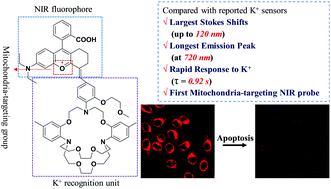A mitochondria-targeting NIR fluorescent potassium ion sensor: real-time investigation of the mitochondrial K+ regulation of apoptosis in situ†
Abstract
The first NIR fluorescent mitochondria-targeting K+ sensor, denoted as TAC-Rh, was developed. The produced sensor consists of a rhodamine analog as the fluorophore and triazacryptand (TAC) as the K+ recognition unit. Compared to the K+ sensors reported previously, TAC-Rh exhibits two unique optical properties: the largest Stokes shifts (120 nm) and the longest emission peak wavelength (720 nm). With the assistance of this novel sensor, real-time changes of K+ concentrations in mitochondria during apoptosis were monitored for the first time. Moreover, it was also the first time that the relationship between mitochondrial K+ flux and apoptosis was investigated in real time using fluorescence imaging.



 Please wait while we load your content...
Please wait while we load your content...